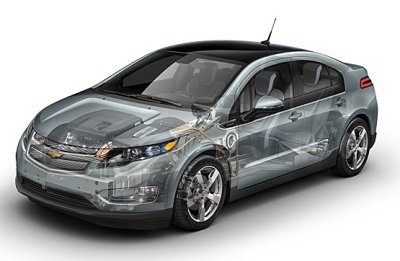
The anatomy of the new Chevy Volt electric car. (Image: General Motors)
COLLEGE PARK (April 21, 2010)—The strong-selling Toyota Prius made it clear, and tougher federal gas mileage standards made it even clearer: environmentally friendly cars can't be just "a hobby" for General Motors.
GM has dabbled in green technologies for years, building a handful of two-seat electrics in the 1990s, experimenting with hydrogen fuel cell technology and using gas-electric hybrid drivetrains to add one or two miles per gallon to some of its existing products.
Speaking Wednesday to an audience of University Maryland students, Keith Cole, GM's legislative and regulatory affairs director, promised that the automaker's latest effort will be different.
Cole described the upcoming 2011 Chevrolet Volt, a four-door, four-passenger compact hatchback, as the perfect mix between an all-electric car and existing gas-electrics like the Prius.
The Volt—which is scheduled to begin appearing on dealer lots in the Washington area, Detroit and California this fall—is powered by electric batteries with an estimated range of 40 emissions-free miles.
But unlike an all-electric car—in which the driver would need to track down an electrical outlet to charge the car's depleted battery—the Volt also includes a gasoline engine that serves as a generator to recharge the battery, even as the battery continues to power the vehicle.
Drivers who typically travel less than 40 miles a day would therefore use no gas—plugging their cars in overnight to charge between commutes. The gasoline "range extender" kicks in for longer trips or unexpected detours.
This package would likely hold broad appeal at mainstream-level prices, but even at the rumored price tag of more than $30,000, the Volt's look and feel make it distinct from an entry-level economy car.
The shape of the car was determined by its aerodynamics, leaving it with a distinctively high rear end. The front is adorned with a handsome application of Chevrolet's split-grille design element.
The Volt's interior also feels a cut above economy grade. The instrument panel uses a glossy white plastic that's more often seen adorning an Apple computer than the inside of a car, leaving a pervasive impression of advanced technology. Vibrant graphic display screens further separate it from the automotive norm. The four leather seats are roomy and comfortable.
But for all that aesthetic uniqueness, the drive of the Volt feels conventional, even compared to a Prius. The steering and brakes feel natural. There's plenty of pep. The seating position, while a bit lower than some cars, doesn't serve as a reminder that this is a special automobile.
The car is quiet, of course. The electric motor emits a faint whine under acceleration, but even when the gasoline engine is running to recharge the batteries, it's drowned out by standard wind and road noise. Because the electric motor actually powers the vehicle, the gas engine is always running at the equivalent of idle, providing no more noise than you'd hear if you were to roll down the street in a gas-powered car in neutral.
The short test drives GM offered at the University of Maryland stayed at low speeds, but the noise levels in the Volt would not likely stray too far below the average car, as wind and road noise is the dominant sound on the highway anyway. And as a nod to pedestrians who might not hear the near-silent motor, the Volt lets drivers pull on the headlight-control stalk to activate a quiet horn as a warning that an electric car is approaching.
The Volt's electric underpinning and environmental focus do force some compromises in its utility compared to a gas-powered small hatchback.
Aerodynamics, not practicality, have dictated the roofline, which requires ducking low to hop into the back seat—one passenger hit her head as she got in. The Volt's shape also cuts into the view out the back and to the sides, although the instrument panel's screen includes a rearview camera display. And the battery pack running from the front to the back of the car consumes what would normally be a fifth seating position.
Those quibbles aside, the Volt is for the most part a normal-feeling and very pleasant small car that happens to use no gasoline on a 40-mile drive, needing instead only about 80 cents worth of electricity.
The only compromise, then, is the cost. GM hasn't said what it will charge for its Volt, but estimates continue to float around $35,000 to $40,000.
"We're not setting a price yet, but it's gonna be affordable, it's gotta be affordable," GM project engineer Doug Baker said, as he sat in the passenger seat of a pre-production Volt prototype while a Prius owner sampled the car on the streets of the University of Maryland campus.
"So that's, like, low 20s?" replied Ann Wylie, the university's vice president for administrative affairs, quoting a figure similar to the $22,800 starting price of a Prius.
"Ah, probably not that low," Baker said.
Even factoring in an anticipated $7,500 federal tax credit for Volt buyers, the price will likely be more than twice that of a standard compact sedan like a Toyota Corolla or Chevrolet's Cobalt, and at least $8,000 more than the Prius.
The upcoming Nissan Leaf electric car—like the Volt and Prius, a four-door hatchback—will also likely undercut the Volt's price, starting at just over $25,000 with its own federal tax credit. The Leaf, too, is set to go on sale later this year, and to travel 100 miles per battery charge.
But while the Prius is fuel-efficient—the Environmental Protection Agency pegs it at 50 miles per gallon—it can only go gas-free under very gentle acceleration at low speeds. And after that 100 miles, a Nissan Leaf owner had better be near an electrical outlet and be prepared to wait a few hours for the battery to recharge.
With the Volt "you don't have to find an outlet, you just have to find a gas station," Baker said. "And that's one of the things we've looked at, is you can build an all-electric vehicle, but how useful is it if you're anxious about driving it?"
But the bigger questions are whether there is a market for such a car at $30,000 or more, and whether GM would be prepared to serve such a market if there is one.
GM officials at the Wednesday event said the automaker had not yet determined how many Volts it will build—recent volume estimates have not approached even a third of the 140,000 Priuses sold last year—and the car remains a work in progress unusually close to the production date.
The hand-built Volt prototype driven and displayed at the forum is fully functioning, but Baker said it did not include the final interior design or throttle calibration. The prototype also suffered from some loose interior panels, a clunky gear selector, a driver's door that several drivers needed multiple attempts to slam fully shut, and occasionally jerky operation from the windshield wipers.
"If you want to affect petroleum consumption and greenhouse gas emissions, if it doesn't scale, it's just a hobby," Cole said at the forum. "And that's what we were doing (in the 1990s)—we spent a billion dollars and we had a hobby."
How the Volt translates into a mass-market production car will determine whether GM has spent even more to do more of the same.
Capital News Service contributed to this report.
RELATED INFORMATION:
GM Volt Website
http://www.chevrolet.com/pages/open/default/future/volt.do
GM Volt Fan Website
http://gm-volt.com/


